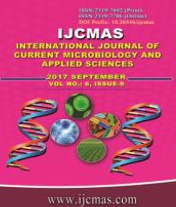


 National Academy of Agricultural Sciences (NAAS)
National Academy of Agricultural Sciences (NAAS)

|
PRINT ISSN : 2319-7692
Online ISSN : 2319-7706 Issues : 12 per year Publisher : Excellent Publishers Email : editorijcmas@gmail.com / submit@ijcmas.com Editor-in-chief: Dr.M.Prakash Index Copernicus ICV 2018: 95.39 NAAS RATING 2020: 5.38 |
Urinary tract infections caused by multidrug resistant bacteria are increasingly becoming prevalent even in rural areas. Objective of the present study was to find out the distribution and antibiotic resistance pattern of urinary isolates over a period of one year in a tertiary care centre of Central Kerala which has got a rural location. We analyzed the types and antibiotic resistance pattern of all significant urinary isolates in the microbiology department from May 2016 - April 2017. Of the 3772 urine samples processed, 1265(33.5%) showed significant bacteriuria. The predominant isolate was E. coli (48.9%) followed by Klebsiella sp. (14%), Enterococcus sp. (14%), Staphylococcus sp. (7%), Pseudomonas and other non-fermenters (11%). Among Enterobacteriaceae, 64.7% was ESBL producers and 15.75% were carbapenem resistant. Around 63% of E.coli and Klebsiella sp. were found to be resistant to fluoroquinolones like norfloxacin and ciprofloxacin. Ampicillin resistance was observed in 35% of Enterococcus isolates and vancomycin resistance in 0.65%. Of the Staphylococcal isolates, 79.5% was methicillin resistant. From our study, we could realize that the problem of antibiotic resistance is increasing in an alarming rate even in rural areas. Multidrug resistance, since being a universal problem, we all have to be vigilant against this menace and the need for antibiotic stewardship should be reiterated.
 |
 |
 |
 |
 |